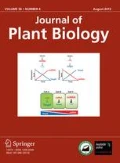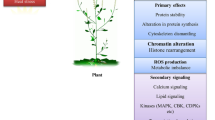Abstract
Small heat shock proteins (sHSPs) are an HSP subgroup and involved in environmental stress response. In the current study, to understand the role of sHSP protein in a widely distribution nut woody tree, a sHSP gene was cloned from Juglans regia (JrsHSP17.3, GeneBank No.: KT277704). Compared with control condition, the expression of JrsHSP17.3 was induced to 58.1-fold (6 h) in the roots, 86.8-fold in the stems (9 h), 50.9-fold in the leaves (6 h) under 10°C; and was up-regulated to 2.9- ∼ 79.9-fold response to 40°C for 3∼9 h; meanwhile, it was transcribed to 5.9 - ∼39.7-fold under 9 h NaCl treatment, suggesting the potential role of JrsHSP17.3 to cold, heat and NaCl stimulus. Further, JrsHSP17.3 transgenic yeasts showed improved tolerance to freezing, heat and salt stresses compared with control yeast. JrsHSP17.3 was transient over-expressed in J. regia leaves. The leaves non-transgenic (NT) and vector prokII transgenic (empty, PT) were used as control. The expression of JrsHSP17.3 was 81.6-, 125.4-, and 54.2-fold of the control lines under normal conditions, indicating the success over-expression of JrsHSP17.3. Cell damage staining and physiological index determination showed that JrsHSP17.3 transformed lines, NT and PT displayed no obvious difference under control conditions, however, after treated with 16°C, 40°C and NaCl, JrsHSP17.3 transformed lines displayed weaker cell damage, lower level of electrolyte leakages (EL) rate, malondialdehyde (MDA) and H2O2 content, and higher activities of catalase (CAT), glutathione transferase (GST), superoxide dismutase (SOD) and peroxidase (POD) as well as more accumulation of proline than NT and PT. Meanwhile, NT and PT were similar and showed no significant difference under all conditions. All of these results indicated that JrsHSP17.3 can improve plant tolerance to abnormal temperatures and NaCl stresses, it represents a potential candidate gene for molecular breeding to enhance stress tolerance in plants.
Similar content being viewed by others
References
Abdallah IB, Tlili N, Martinez-Force E, Rubio AG, Perez-Camino MC, Albouchi A, Boukhchina S (2015) Content of carotenoids, tocopherols, sterols, triterpenic and aliphatic alcohols, and volatile compounds in six walnuts (Juglans regia L.) varieties. Food Chem 173:972–978
Aslamarz AA, Vahdati K, Hassani D, Rahemi M, Mohammadi N, Leslie C (2011) Cold hardiness and its relationship with proline content in Persian walnut. European J Horticul Sci 76:84–90
Aslamarz AA, Vahdati K, Rahemi M, Hassani D, Leslie C (2010) Supercooling and cold-hardiness of acclimated and deacclimated buds and stems of Persian walnut cultivars and selections. HortScience 45:1662–1667
Avelange-Macherel MH, Payet N, Lalanne D, Neveu M, Tolleter D, Burstin J, Macherel D (2015) Variability within a pea core collection of LEAM and HSP22, two mitochondrial seed proteins involved in stress tolerance. Plant Cell Environ 38:1299–1311
Bondino H, Valle E, ten Have A (2012) Evolution and functional diversification of the small heat shock protein/a-crystallin family in higher plants. Planta 235:1299–1313
Dat J, Vandenabeele S, Vranova E, Van Montagu M, Inzé D, Van Breusegem F (2000) Dual action of the active oxygen species during plant stress responses. Cell Mol Life Sci 57:779–795
De Jong W, Leunissen J, Voorter C (1993) Evolution of the alphacrystallin/small heat-shock protein family. Mol Biol Evol 10:103–126
De Jong WW, Caspers GJ, Leunissen JAM (1998) Genealogy of the a-crystallin-small heat-shock protein superfamily. Int J Biol Macromol 22:151–162
Fleckenstein T, Kastenmüller A, Stein ML, Peters C, Daake M, Krause M, Weinfurtner D, Haslbeck M, Weinkauf S, Groll M, Buchner J (2015) The chaperone activity of the developmental small heat shock protein Sip1 is regulated by pH-dependent conformational changes. Mol Cell 58:1067–1078
Gao C, Jiang B, Wang Y, Liu G, Yang C (2012) Overexpression of a heat shock protein (ThHSP18. 3) from Tamarix hispida confers stress tolerance to yeast. Mol Biol Rep 39:4889–4897
Groušl T, Ivanov P, Frydlová I, Vašicová P, Janda F, Vojtová J, Malínská K, Malcová I, Nováková L, Janošková D (2009) Robust heat shock induces eIF2a-phosphorylation-independent assembly of stress granules containing eIF3 and 40S ribosomal subunits in budding yeast, Saccharomyces cerevisiae. J Cell Sci 122:2078–2088
Guan J, Jinn T, Yeh C, Feng S, Chen Y, Lin C (2004) Characterization of the genomic structures and selective expression profiles of nine class I small heat shock protein genes clustered on two chromosomes in rice (Oryza sativa L.). Plant Mol Biol 56:795–809
Howarth C (1991) Molecular responses of plants to an increased incidence of heat shock. Plant Cell Environ 14:831–841
Jariteh M, Ebrahimzadeh H, Niknam V, Mirmasoumi M, Vahdati K (2015) Developmental changes of protein, proline and some antioxidant enzymes activities in somatic and zygotic embryos of Persian walnut (Juglans regia L.). Plant Cell Tiss Org Culture 122:101–115
Jariteh M, Ebrahimzadeh H, Niknam V, Vahdati K, Amiri R (2011) Antioxidant enzymes activities during secondary somatic embryogenesis in Persian walnut (Juglans regia L.). Afr J Biotechnol 10:4093–4099
Jiang Y, Yang B, Harris NS, Deyholos MK (2007) Comparative proteomic analysis of NaCl stress-responsive proteins in Arabidopsis roots. J Exp Bot 58:3591–3607
Kaur H, Petla B P, Kamble N U, Singh A, Rao V, Salvi P, Ghosh S, Majee M (2015) Differentially expressed seed aging responsive heat shock protein OsHSP18.2 implicates in seed vigor, longevity and improves germination and seedling establishment under abiotic stress. Front Plant Sci 6(713)
Krishna P (2004) Plant responses to heat stress plant responses to abiotic stress. Top Curr Genet 4:73–101
Lee GJ, Roseman AM, Saibil HR, Vierling E (1997) A small heat shock protein stably binds heat-denatured model substrates and can maintain a substrate in a folding-competent state. EMBO J 16:659–671
Lee KW, Cha JY, Kim KH, Kim YG, Lee BH, Lee SH (2012) Overexpression of alfalfa mitochondrial HSP23 in prokaryotic and eukaryotic model systems confers enhanced tolerance to salinity and arsenic stress. Biotechnol Lett 34:167–174
Liu WW, Yang P, Chen XM, Xu DL, Hu YH (2014) Cloning and expression analysis of four heat shock protein genes in Ericerus pela (Homoptera: Coccidae). J Insect Sci 15
Livak KJ, Schmittgen TD (2001) Analysis of relative gene expression data using real-time quantitative PCR and the 2-CT method. Methods 25:402–408
Lotfi N, Vahdati K, Kholdebarin B, Ashrafi EN (2009) Germination, mineral composition, and ion uptake in walnut under salinity conditions. HortScience 44:1352–1357
Martin-Folgar R, Fuente M, Morcillo G, Martinez-Guitarte JL (2015) Characterization of six small HSP genes from Chironomus riparius (Diptera, Chironomidae): Differential expression under conditions of normal growth and heat-induced stress. Comp Biochem Physiol A Mol Integr Physiol 27:00176–00172
Naser L, Kourosh V, Bahman K, Reza A (2010) Soluble sugars and proline accumulation play a role as effective indices for drought tolerance screening in Persian walnut (Juglans regia L.) during germination. Fruits 65:97–112
Nieto-Sotelo J, Kannan K, Martinez L, Segal C (1999) Characterization of a maize heat-shock protein 101 gene, HSP101, encoding a ClpB/Hsp100 protein homologue. Gene 230:187
Qi Y, Wang H, Zou Y, Liu C, Liu Y, Wang Y, Zhang W (2011) Overexpression of mitochondrial heat shock protein 70 suppresses programmed cell death in rice. FEBS Lett 585:231–239
Reed KC, Mann DA (1985) Rapid transfer of DNA from agarose gels to nylon membranes. Nucleic Acids Res 13(20):7207–7221
Sarkar NK, Kim YK, Grover A (2009) Rice sHsp genes: genomic organization and expression profiling under stress and development. BMC Genomics 10:393
Scarpeci TE, Zanor MI, Valle EM (2008) Investigating the role of plant heat shock proteins during oxidative stress. Plant Signal Behav 3:856–857
Schmidt R, Schippers JHM, Welker A, Mieulet D, Guiderdoni E, Mueller-Roeber B (2012) Transcription factor OsHsfC1b regulates salt tolerance and development in Oryza sativa ssp. japonica. AoB Plants 2012
Sin YY, Martin TP, Wills L, Currie S, Baillie GS (2015) Small heat shock protein 20 (Hsp20) facilitates nuclear import of protein kinase D1 (PKD1) during cardiac hypertrophy. Cell Commun Signal 13:015–0094
Song NH, Ahn YJ (2010) DcHsp17.7, a small heat shock protein from carrot, is upregulated under cold stress and enhances cold tolerance by functioning as a molecular chaperone. HortScience 45:469–474
Sun W, Van Montagu M, Verbruggen N (2002) Small heat shock proteins and stress tolerance in plants. Biochim Biophys Acta 1577:1
Sun X., Sun C, Li Z, Hu Q, Han L, Luo H (2015) AsHSP17, a creeping bentgrass small heat shock protein modulates plant photosynthesis and ABA-dependent and independent signaling to attenuate plant response to abiotic stress. Plant Cell Environ 26(10):12683
Vahdati K, Lotfi N, Kholdebarin B, Hassani D, Amiri R, Mozaffari MR, Leslie C (2009) Screening for drought-tolerant genotypes of Persian walnuts (Juglans regia L.) during seed germination. HortScience 44:1815–1819
Wang L, Xu C, Wang C, Wang Y (2012) Characterization of a eukaryotic translation initiation factor 5A homolog from Tamarix androssowii involved in plant abiotic stress tolerance. BMC Plant Biol 12:118
Wehmeyer N, Hernandez LD, Finkelstein RR, Vierling E (1996) Synthesis of small heat-shock proteins is part of the developmental program of late seed maturation. Plant Physiol 112:747–757
Xu F, Deng G, Cheng SY, Zhang, WW, Huang, XH, Li, LL, Cheng H, Rong, XF, Li JB (2012) Molecular cloning, characterization and expression of the phenylalanine ammonia-lyase gene from Juglans regia. Molecules 17:7810–7823
Yang G, Wang Y, Xia D, Gao C, Wang C, Yang C (2014a) Overexpression of a GST gene (ThGSTZ1) from Tamarix hispida improves drought and salinity tolerance by enhancing the ability to scavenge reactive oxygen species. Plant Cell Tiss Org Culture 117:99–112
Yang G, Wang Y, Zhang K, Gao C (2014b) Expression analysis of nine small heat shock protein genes from Tamarix hispida in response to different abiotic stresses and abscisic acid treatment. Mol Biol Rep 41:1279–1289
Zahur M, Maqbool A, Irfan M, Barozai MY, Qaiser U, Rashid B, Husnain T, Riazuddin S (2009) Functional analysis of cotton small heat shock protein promoter region in response to abiotic stresses in tobacco using Agrobacterium-mediated transient assay. Mol Biol Rep 36:1915–1921
Zheng L, Liu G, Meng X, Li Y, Wang Y (2012) A versatile Agrobacterium-mediated transient gene expression system for herbaceous plants and trees. Biochem Genet 50:761–769
Author information
Authors and Affiliations
Corresponding author
Rights and permissions
About this article
Cite this article
Zhai, M., Sun, Y., Jia, C. et al. Over-expression of JrsHSP17.3 gene from Juglans regia confer the tolerance to abnormal temperature and NaCl stresses. J. Plant Biol. 59, 549–558 (2016). https://doi.org/10.1007/s12374-015-0507-9
Received:
Accepted:
Published:
Issue Date:
DOI: https://doi.org/10.1007/s12374-015-0507-9




